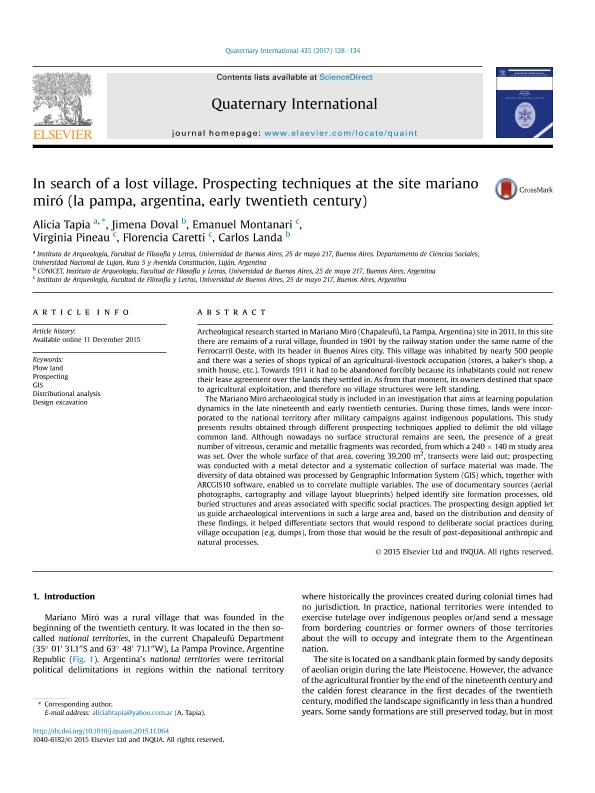Artículo
In search of a lost village: Prospecting techniques at the site mariano miró (la pampa, argentina, early twentieth century)
Tapia, Alicia Haydee; Doval, Jimena ; Montanari, Emanuel; Pineau, Virginia Giselle
; Montanari, Emanuel; Pineau, Virginia Giselle ; Caretti, Florencia; Landa, Carlos Gilberto
; Caretti, Florencia; Landa, Carlos Gilberto
 ; Montanari, Emanuel; Pineau, Virginia Giselle
; Montanari, Emanuel; Pineau, Virginia Giselle ; Caretti, Florencia; Landa, Carlos Gilberto
; Caretti, Florencia; Landa, Carlos Gilberto
Fecha de publicación:
04/2017
Editorial:
Pergamon-Elsevier Science Ltd
Revista:
Quaternary International
ISSN:
1040-6182
Idioma:
Inglés
Tipo de recurso:
Artículo publicado
Clasificación temática:
Resumen
Archeological research started in Mariano Miró (Chapaleufú, La Pampa, Argentina) site in 2011. In this site there are remains of a rural village, founded in 1901 by the railway station under the same name of the Ferrocarril Oeste, with its header in Buenos Aires city. This village was inhabited by nearly 500 people and there was a series of shops typical of an agricultural-livestock occupation (stores, a baker's shop, a smith house, etc.). Towards 1911 it had to be abandoned forcibly because its inhabitants could not renew their lease agreement over the lands they settled in. As from that moment, its owners destined that space to agricultural exploitation, and therefore no village structures were left standing. The Mariano Miró archaeological study is included in an investigation that aims at learning population dynamics in the late nineteenth and early twentieth centuries. During those times, lands were incorporated to the national territory after military campaigns against indigenous populations. This study presents results obtained through different prospecting techniques applied to delimit the old village common land. Although nowadays no surface structural remains are seen, the presence of a great number of vitreous, ceramic and metallic fragments was recorded, from which a 240 × 140 m study area was set. Over the whole surface of that area, covering 39,200 m2, transects were laid out; prospecting was conducted with a metal detector and a systematic collection of surface material was made. The diversity of data obtained was processed by Geographic Information System (GIS) which, together with ARCGIS10 software, enabled us to correlate multiple variables. The use of documentary sources (aerial photographs, cartography and village layout blueprints) helped identify site formation processes, old buried structures and areas associated with specific social practices. The prospecting design applied let us guide archaeological interventions in such a large area and, based on the distribution and density of these findings, it helped differentiate sectors that would respond to deliberate social practices during village occupation (e.g. dumps), from those that would be the result of post-depositional anthropic and natural processes.
Palabras clave:
Design Excavation
,
Distributional Analysis
,
Gis
,
Plow Land
,
Prospecting
Archivos asociados
Licencia
Identificadores
Colecciones
Articulos(SEDE CENTRAL)
Articulos de SEDE CENTRAL
Articulos de SEDE CENTRAL
Citación
Tapia, Alicia Haydee; Doval, Jimena; Montanari, Emanuel; Pineau, Virginia Giselle; Caretti, Florencia; et al.; In search of a lost village: Prospecting techniques at the site mariano miró (la pampa, argentina, early twentieth century); Pergamon-Elsevier Science Ltd; Quaternary International; 435; 4-2017; 128-134
Compartir
Altmétricas



